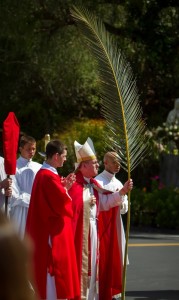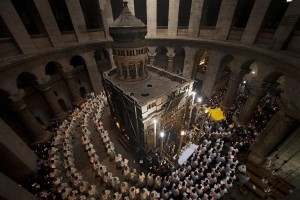 In this day and age when homogenization seems to rule the day, it is wonderful to know that there are some venerable orders like the Dominicans and the Carmelites who still retain their ancient liturgical practices. In particular, the Norbertine liturgy during Holy Week is replete with symbols which echo back to ancient practices. Saint Norbert lived around the time of the Crusades and since the Latin Catholic liturgy was the predominant from of worship in Jerusalem, the liturgical practices of the Church of the Holy Sepulchre in Jerusalem, the site of our Lord’s Crucifixion, Death and Resurrection, had a profound impact on the Norbertine liturgy.
In this day and age when homogenization seems to rule the day, it is wonderful to know that there are some venerable orders like the Dominicans and the Carmelites who still retain their ancient liturgical practices. In particular, the Norbertine liturgy during Holy Week is replete with symbols which echo back to ancient practices. Saint Norbert lived around the time of the Crusades and since the Latin Catholic liturgy was the predominant from of worship in Jerusalem, the liturgical practices of the Church of the Holy Sepulchre in Jerusalem, the site of our Lord’s Crucifixion, Death and Resurrection, had a profound impact on the Norbertine liturgy.
First, the Norbertines’ habit is white, like the original canons of the Church of the Holy Sepulchre, symbolizing the angels who announced the Lord’s Resurrection.
At the end of the Palm Sunday procession, there is an unveilng and a threefold adoration of the Holy Cross, a 12th century practice in the Church of the Holy Sepulchre.
On Good Friday, there is a special form of the unveiling and adoration of the Cross, symbolizing the Eastern and Western Churches uniting at the foot of Calvary.

It is the tradition in the Holy Land to celebrate the Mass of the place versus the Mass of the day. So, for example, in Bethlehem, no matter what the day of the year (with some exceptions), the Mass celebrating the Lord’s birth is the order of the day. It is also true that in the Church of the Holy Sepulchre, the Easter Mass is usually celebrated every single day of the year. The Norbertines imitated this practice by celebrating the Mass of Easter each Sunday of Easter. At St. Michael’s Abbey in California, the Easter Antiphon of Easter Sunday is sung on each Sunday of the Easter season.
Finally, the Church calls for all the faithful to bow in reverence during the Nicene Creed when we recall the Incarnation. The Norbertines extend this reverence when the Nicene Creed is sung though the words professing faith in Jesus’ Burial and they rise from this reverence when they profess faith in His Resurrection. Once again, this practice comes from the Church of the Holy Sepulchre.
For more information, see the Spring 2013 issue of the St. Michael Messenger from St. Michael’s Abbey in Silverado, CA. If you are nearby a Norbertine Abbey, try attend a Norbertine liturgy and deepen your experience of Holy Week and the holy season of Easter. You don’t have to be a pilgrim to the Holy Land to experience a little bit of the uniqueness that comes from these ancient and deeply moving liturgical traditions.